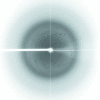Crystallization and preliminary X-ray analysis of the reduced Rieske-type [2Fe-2S] ferredoxin derived from Pseudomonas sp. strain KKS102
- PMID: 17401203
- PMCID: PMC2330217
- DOI: 10.1107/S1744309107009992
Crystallization and preliminary X-ray analysis of the reduced Rieske-type [2Fe-2S] ferredoxin derived from Pseudomonas sp. strain KKS102
Abstract
The reduced form of BphA3, a Rieske-type [2Fe-2S] ferredoxin component of the biphenyl dioxygenase BphA from Pseudomonas sp. strain KKS102, was crystallized by the sitting-drop vapour-diffusion method under anaerobic conditions. The crystal belongs to space group P3(1)21, with unit-cell parameters a = b = 49.6, c = 171.9 A, and diffracts to a resolution of 1.95 A. A molecular-replacement calculation using oxidized BphA3 as a search model yielded a satisfactory solution.
Figures




References
Publication types
MeSH terms
Substances
LinkOut - more resources
Full Text Sources

